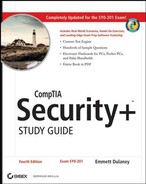Chapter 1. General Security Concepts
THE FOLLOWING COMPTIA SECURITY+ EXAM OBJECTIVES ARE COVERED IN THIS CHAPTER:
1.6 Explain the purpose and application of virtualization technology.
2.2 Distinguish between network design elements and components.
DMZ
VLAN
NAT
Network interconnections
NAC
Subnetting
Telephony
3.7 Deploy various authentication models and identify the components of each.
Biometric reader
Kerberos
CHAP
PAP
Mutual
3.8 Explain the difference between identification and authentication (identity proofing).
 Security is unlike any other topic in computing. To begin with, the word is so encompassing that it is impossible to know what you mean just by using it. When you talk about security, do you mean physical security of servers and workstations and protecting them from those who might try to steal them or from damage that might occur if the side of the building collapses? Or do you mean the security of data and protecting it from viruses and worms or from hackers and miscreants who have suddenly targeted you and have no other purpose in life than to keep you up at night? Or maybe security to you is the comfort that comes in knowing that you can restore files if a user accidentally deletes them.
Security is unlike any other topic in computing. To begin with, the word is so encompassing that it is impossible to know what you mean just by using it. When you talk about security, do you mean physical security of servers and workstations and protecting them from those who might try to steal them or from damage that might occur if the side of the building collapses? Or do you mean the security of data and protecting it from viruses and worms or from hackers and miscreants who have suddenly targeted you and have no other purpose in life than to keep you up at night? Or maybe security to you is the comfort that comes in knowing that you can restore files if a user accidentally deletes them.
The first problem with security is that it is next to impossible for everyone to agree on what it means because it can include all of these items. The next problem with security is that we don't really mean that we want things to be completely secured. If you wanted the customer list file to truly be secure, you would never put it on the server and make it available. It is on the server because you need to access it and so do 30 other people. In this sense, security means that only 30 people can get to it and not anyone outside of the select 30.
The next problem is that while everyone wants security, no one wants to be inconvenienced by it. To use an analogy, few are the travelers who do not feel safer by watching airport personnel frisk and pat down all who head to the terminal—they just don't want it to happen to them. This is true in computing as well; we all want to make sure data is accessed only by those who truly should be working with it, but we don't want to have to enter 12-digit passwords and submit to retinal scans.
As a computer security professional, you have to understand all of these concerns. You have to know that a great deal is expected of you but few users want to be hassled or inconvenienced by the measures you must put in place. You have a primary responsibility to protect and safeguard the information your organization uses. Many times that means educating your users and making certain they understand the "why" behind what is being implemented.
Security is a high-growth area in the computer industry, and it has been for several years now. The need for qualified people is increasing rapidly, as a search of job boards will quickly illustrate. Your pursuit of the Security+ certificate is a good first step in this process. Security+ is not the only security certification on the market, and it is not even the only entry-level certification available to you. It is, however, the only one to truly focus on the topics that most think of when security comes to mind. To pass it, you must have a broad knowledge of all the different types of security mentioned in the first paragraph.
In this chapter, I'll discuss the various aspects of computer security as they relate to your job. I will introduce the basics of computer security and provide several models you can use to understand the risks your organization faces. Not stopping there, I will also present steps you must take in order to minimize those risks.
